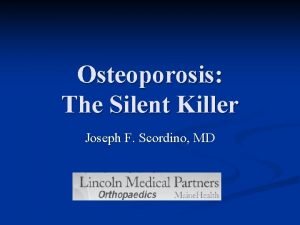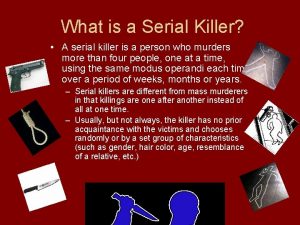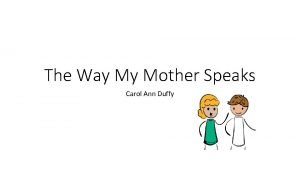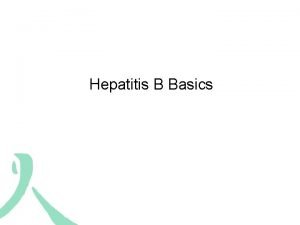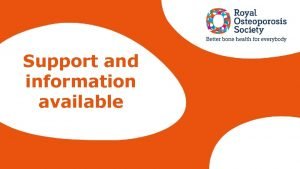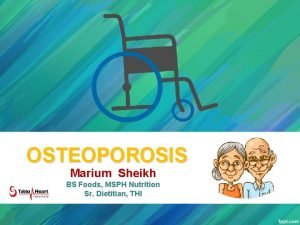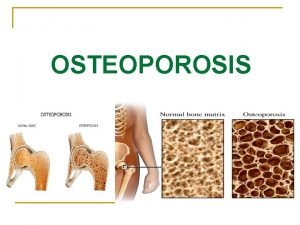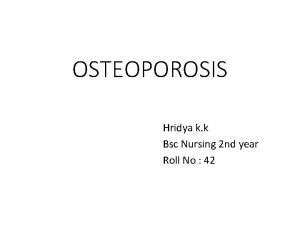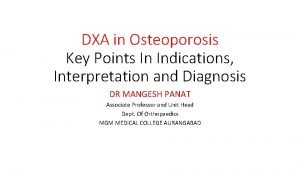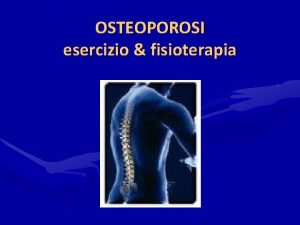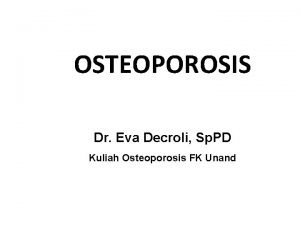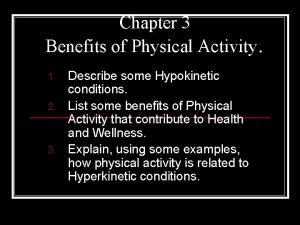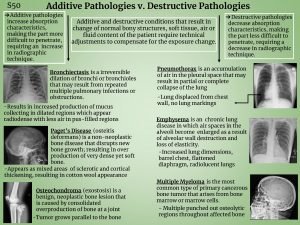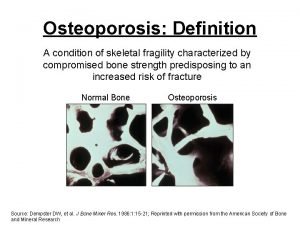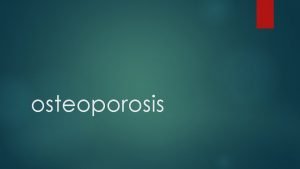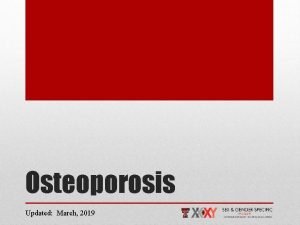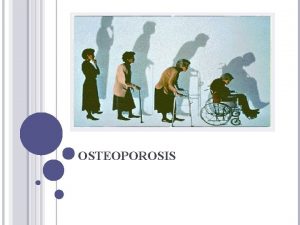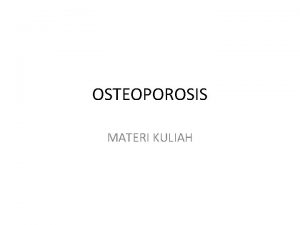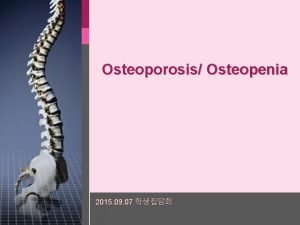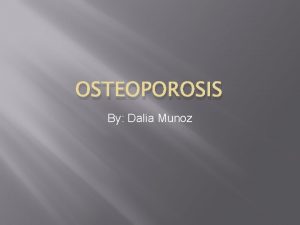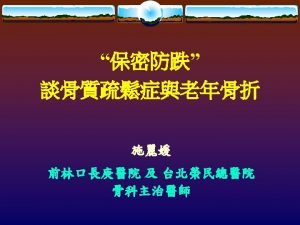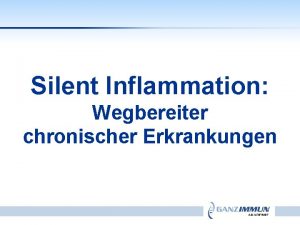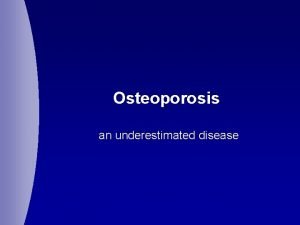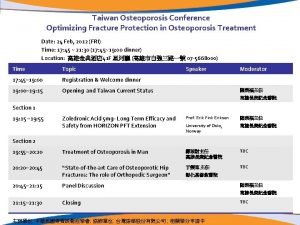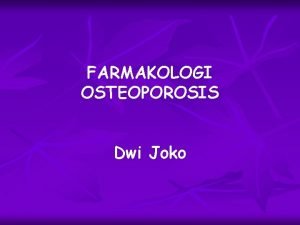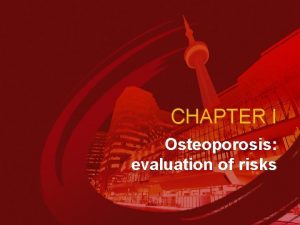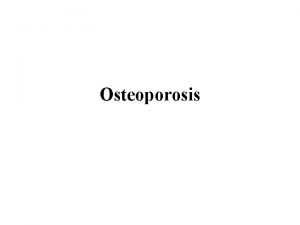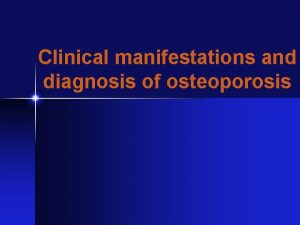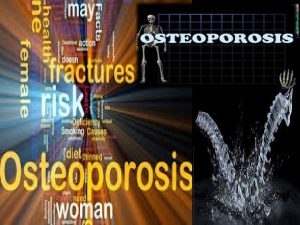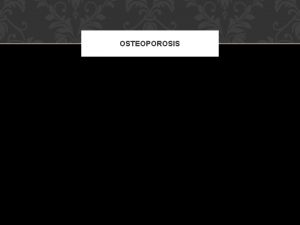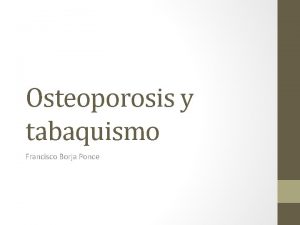Osteoporosis The Silent Killer Joseph F Scordino MD
































- Slides: 32

Osteoporosis: The Silent Killer Joseph F. Scordino, MD

Lincoln County Maine oldest state in the country n Lincoln county oldest county in the state n

Osteoporosis n n n Osteoporosis is a disease that causes the bones to become brittle and fragile and more likely to break. It is a silent disease in that it does not cause pain until the bone breaks. Osteoporosis is most likely to cause fractures of the spine, hip or wrist which can lead to hospitalization or loss of independent living. Spine fractures can cause spinal deformity and severe pain in the back

Osteoporosis Under the Microscope Build bone early in teens and twenty n Constantly remodeling n Normal Bone

Prevalence n n n Approximately one in two women and one in four men over age 50 will have an osteoporosis related fracture in their remaining lifetime. Major threat for 44 million Americans or greater then 50% of Americans over age 50 Osteoporosis can affect any individual of any age 80% of this pool of patients are women Osteoporosis is more predominant in White and Asian ethnic groups then in other groups


Consequences n n n Osteoporosis bone fractures are responsible for considerable pain, decreased quality of life, lost workdays, and disability. Some 20% of women with a hip fracture will die in the subsequent year as an indirect result of the fracture. In addition, once a person has experienced a spine fracture due to osteoporosis, he or she is at very high risk of suffering another such fracture in the near future (next few years).

Effect on Independence At six months after a hip fracture, only 15 percent of hip fracture patients can walk across a room unaided. n Up to 30% of patients suffering a hip fracture will require long-term nursing-home care. n

Symptoms People cannot feel their bones getting weaker. They may not know that they have osteoporosis until they break a bone. A person with osteoporosis can fracture a bone from a minor fall, or in serious cases, from a simple action such as a sneeze or even spontaneously. n Women can lose up to 20 percent of their bone mass in the five to seven years after menopause, making them more susceptible to osteoporosis. n

Peak Bone Mass n Peak bone mass is obtained at around age 20 healthy diet. Building strong bones in childhood helps to decrease fracture risk later in life.

Vertebral Fractures n Vertebral (spinal) fractures may initially be felt or seen in the form of severe back pain, loss of height, or spinal deformities such as kyphosis or stooped posture. In many cases, a vertebral fracture can even occur with no pain.

Postural Deformity

Who Should be Screened n n NOF Screen > 65. Less then 65 based on risk factors 1) , 100 lbs 2) FH of fracture 3) incidence of previous fracture

Risk Factors n n n n Age Female Sex Race Low weight or BMI Previous Fracture Parental history of hip fracture Steroid use n n n n Current smoking Alcohol > 3 drinks a day Rheumatoid Arthritis Inflammatory Bowel disease Prolonged Immobilization Type 1 Diabetes Thyroid Disorder

Fractures n n 1 in 2 women after age 50 will have a osteoporotic fracture in their lifetime while for men this 1 in 4. Fractures due to osteoporosis lower an individuals quality of life 25% of individuals die within 1 year of an osteoporotic fracture 1 in 6 individuals previously independent individuals require long term care following a fracture

Diagnosis n n A specialized machine called a bone mineral density test can be used to measure the extent of osteoporosis at various sites BMD is safe and painless Bone density testing helps to monitor response to treatment as well as predict the chance of future fractures Medicare reimburses for BMD testing every 2 years

How to make sense of BMD testing BMD compares your BMD to a healthy 30 year old this is the T score which stands for standard deviations n Lower score is worse n -1 to 1 is a normal bone density test n -1 to -2. 5 is termed osteopenia n -2. 5 or less is termed osteoporosis n Z score is comparison to similar age adults and is less helpful then the T score n

When to Treat Individuals with T score less then -2. 5 n Individuals with T score from -1 to -2. 5 with risk factors n

FRAX score Easy to use program to give score for probability of hip fracture in 10 years time n Requires a DEXA scan n http: //www. sheffield. ac. uk/FRAX/ n

Preventative Steps Remove all obstacles like throw rugs and long phone cords n Install handles next to toilets and showers n Do not wear sandals or slippers without backs n Use 100 watt light bulbs instead of low light n Install night lights to help to see when getting up to go the bathroom n Review all medications with the doctor which may cause dizziness n

Treatment of Osteoporosis Fall prevention n Proper Nutrition n Exercise and weight bearing activities regularly n Medication n

Measures to Decrease Risk Stop excessive alcohol use n Stop smoking – ask for help if needed n

Exercises Hold onto the back of a sturdy chair and stand on one foot for 1 minute n Hold onto the back of a sturdy chair and rock onto your toes and your heels 10 times n Perform with 2 hands, then as you get stronger go to one hand, then one fingertip, then no hands and finally with your eyes closed. n

Medication - Antiresportive Bisphonates orally (Actonel, Fosamax) n Bisphosponates IV once a year (Zolendronic Acid or Reclast) n Calcitonin (Miacalcin) n Estrogen Therapy n

Medication Calcium 1200 mg to 1500 mg by mouth every day for postmenopausal women n Vitamin D 800 mg by mouth every day n Vitamin D 3 has been shown to be equivalent to vitamin D 2. n

Foods high in Calcium

Foods high in Vitamin D

Patient Non adherence Greater then 50% of patients stop taking within 1 year associated with cost, concern for to many medications, dosing regimen, side effects.

Summary Osteoporosis is a disease where bone becomes more fragile with increase risk of fracture n Peak bone mass develops in 20’s then drops n Key risk factors for osteoporosis include genetic factors, lack of exercise, lack of calcium and vitamin D, personal history of fracture as an adult, rheumatoid arthritis, cigarette smoking, excessive alcohol consumption, low body weight, and family history of osteoporosis. n

Summary n n n Patients with osteoporosis have no symptoms until bone fractures occur. Diagnosis can be suggested by X-rays and confirmed by using tests to measure bone density. Treatments for osteoporosis, in addition to prescription osteoporosis medications, include stopping use of alcohol and cigarettes, and assuring adequate exercise, calcium, and vitamin D.

Miles Initiatives n n n Beginning a new osteoporosis treatment protocol to increase treatment for osteoporosis and cut down on future fractures Increase screening for osteoporosis through reinforcement of education with health care providers Educate community and increase awareness about osteoporosis through talks, press releases

Questions?
 Dr joseph scordino
Dr joseph scordino How many types of serial killers are there
How many types of serial killers are there The way my mother speaks carol ann duffy annotated
The way my mother speaks carol ann duffy annotated Hepatitis b is a silent killer
Hepatitis b is a silent killer Royal osteoporosis society leaflets
Royal osteoporosis society leaflets Pes statement for osteoporosis
Pes statement for osteoporosis Osteoporosis defination
Osteoporosis defination Osteoporosis subjective data
Osteoporosis subjective data Osteoporosis
Osteoporosis Osteoporosis t score
Osteoporosis t score Bendaggio
Bendaggio Pathway hiperkalemia
Pathway hiperkalemia Dr eva decroli
Dr eva decroli Is osteoporosis hypokinetic or hyperkinetic
Is osteoporosis hypokinetic or hyperkinetic Osteoporosis
Osteoporosis Additive pathology in radiography
Additive pathology in radiography Tbs osteoporosis
Tbs osteoporosis Alendronate mechanism
Alendronate mechanism Loss defination
Loss defination Thế nào là mạng điện lắp đặt kiểu nổi
Thế nào là mạng điện lắp đặt kiểu nổi Hát kết hợp bộ gõ cơ thể
Hát kết hợp bộ gõ cơ thể Sự nuôi và dạy con của hươu
Sự nuôi và dạy con của hươu Dạng đột biến một nhiễm là
Dạng đột biến một nhiễm là Nguyên nhân của sự mỏi cơ sinh 8
Nguyên nhân của sự mỏi cơ sinh 8 Phản ứng thế ankan
Phản ứng thế ankan Chó sói
Chó sói Thiếu nhi thế giới liên hoan
Thiếu nhi thế giới liên hoan điện thế nghỉ
điện thế nghỉ Tia chieu sa te
Tia chieu sa te Một số thể thơ truyền thống
Một số thể thơ truyền thống Trời xanh đây là của chúng ta thể thơ
Trời xanh đây là của chúng ta thể thơ Thế nào là hệ số cao nhất
Thế nào là hệ số cao nhất Lp html
Lp html
